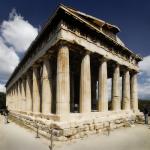|
This section contains 586 words (approx. 2 pages at 300 words per page) |

|
Rich Colonies. The Greek settlements up and down the coastal strip of Ionia were quite prosperous in the sixth century B.C.E. They had sufficient wealth to pay for the construction of considerable buildings, some of them of a colossal size. Examples are the huge temples of Hera (in her large sanctuary on Samos), Artemis (at Ephesus), and Apollo (on Lesbos and at Didyma). More-modest temples were built on Chios, at Mytilene, and in Phocaea. Early in the Archaic Period (700-480 B.C.E.) Samos and Miletus were rich enough to give assistance to the cities in Euboea at war with each other. Further evidence of the Ionians' prosperity is the large number of ships that they were able to build during the Ionian revolt against Persia in 494 B.C.E. Miletus, which had reached the...
|
This section contains 586 words (approx. 2 pages at 300 words per page) |

|




